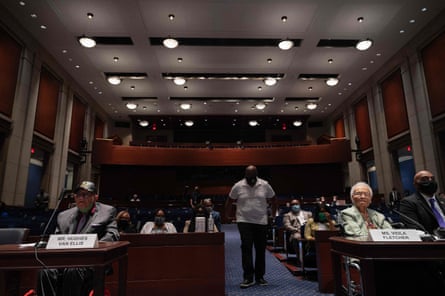Olivia Evans, Louisville Courier Journal
Tue, June 27, 2023
With a month left before their contract expires, the union representing more than 340,000 UPS workers is calling for "practice pickets" nationwide.
In Louisville, that means thousands of Teamsters Local 89 members will begin practicing a picket line Wednesday morning at Worldport, the largest sorting and logistics facility in America.
The Louisville action comes days after the International Brotherhood of Teamsters General President Sean O'Brien called for practice pickets nationwide after claiming UPS presented an "appalling economic counterproposal" to the Teamsters during national negotiations for a new labor contract.
More on the UPS negotiations: UPS Teamsters union employees pass strike action vote. What that means for you.
"These are being coordinated across the country; we wanted to do it as soon as we could," said Stephen Piercey, the communications director for Teamsters Local 89, which represents roughly 10,000 UPS employees in Louisville.
Despite the nationwide practice pickets, UPS says it remains confident that a new contract will be reached.
"We are making steady progress in our negotiations with the Teamsters on a wide array of issues," said Laura Holmberg, a spokesperson for UPS. "Even so, we are not surprised to see some union members making their voices heard."
Is a 'practice picket' a strike?
It is not a strike.
"It's kind of a mock picket line," Piercey said. It serves as a training exercise and prepares members, many of whom have never been on a picket line. "It also kind of serves as a little bit of a rally," he said.
Union members also hope the practice picket moves UPS to meet some of their negotiating demands.
"A practice picket is one of the most powerful or aggressive job actions you can take, and it is typically ... the last thing you do prior to a potential legal strike," Piercey said. "It's meant to serve many functions, but one of the biggest is it's kind of meant to be a shot across the bow at the company saying, 'This is what's coming if you guys don't get serious and give our members what they want.'"
A strike, unlike a practice picket, is a legal action the union can choose to take only after the contract is expired.
Will the practice picket impact me as a consumer?
No.
Employees who are on the clock during the practice picket are expected to go to work and not participate. Piercey said one of the first things union members are told ahead of the practice picket is, "Do not be late to your shift ... this is a training exercise it's not an actual picket."
Teamsters are explicitly instructed to not interfere with or disturb working operations for employees on the clock, to not disparage the employer, to not tell the public to boycott the company, along with other items. The union members are expected to remain peaceful for the duration of the practice picket.
Teamsters Local 89 anticipates the practice picket, which will start at 10 a.m., to last roughly 45 minutes.
Why are local UPS workers practice picketing?
At midnight on July 31, the contract between UPS and the Teamsters will expire if an agreement is not reached between the two sides.
The two entities have been negotiating for a few months and have reached some tentative agreements on items such as air conditioning measures and heat safety.
After negotiating non-economic components of the contract, Teamsters and UPS have recently shifted to focus on negotiating pay, benefits and other financial elements. On June 22, the Teamsters tweeted their disappointment in UPS' counterproposal to economic negotiations.
Piercey said he hopes the nationwide practice pickets, including the one in Louisville, will encourage "the company to action, to get them to get serious at the table and not play games anymore." The last time the Teamsters held a strike was in 1997.
In a statement to the Courier Journal, Holmberg at UPS said, "We plan and expect to reach agreement on a new contract before the end of July that is a win for our employees, our company and customers and the union."
For you: UPS to change Friday operations in response to reduction in package volume
Union members also say they look forward to reaching a contract agreement.
"Really, all we're trying to accomplish is to activate our members, make sure they're engaged and make sure they know and to send a signal to UPS that if they don't get serious that we are prepared to do whatever it takes for us to win the contract our members deserve," Piercey said. "None of us want to see a strike at UPS."
This story will be updated.
Contact reporter Olivia Evans at oevans@courier-journal.com or on Twitter at @oliviamevans_
This article originally appeared on Louisville Courier Journal: UPS Teamsters hold 'practice picket' in KY as potential strike looms
Glenn Taylor
Updated Tue, June 27, 2023

A potential Aug. 1 strike is still on the table for more than 330,000 UPS workers, with the union behind them stepping up labor contract negotiations with an unwavering message: pay up.
After a Thursday meeting where the International Brotherhood of Teamsters shared their full economic proposal with UPS for a new five-year contract, the union voiced its displeasure with the shipping company’s “appalling” counterproposal, declaring “no more meetings until money gets real.”
“The Teamsters will not bargain or accept any contract that’s cost-neutral,” said Sean M. O’Brien, general president of the Teamsters, during the meeting. “We are not going to sell ourselves short in these negotiations, and we will not buy back terms and conditions to protect our members. We have 39 days to go. This company is wasting time putting forth offensive proposals. If UPS wants to negotiate a contract for 1997 working conditions, they’re going to get 1997 consequences.”
O’Brien didn’t share the full financial details of the Teamsters proposal, but said it was “the biggest economic proposal in labor history.”
The proposal’s priorities included wage increases each year of the contract, “catch-up raises” for part-time employees, additional holidays and more paid time off, pension increases, as well as protection and enhancement of existing health and welfare benefits.
The union also wants to eliminate the two-tier 22.4 job classification, which the Teamsters say penalizes junior workers who perform the same functions as senior workers, and create more full-time jobs created over the next five years.
On Thursday, UPS described the talks’ progress toward a new national master agreement as “strong,” with both parties agreeing on all non-economic issues.
According to O’Brien, the delivery company and the union members have reached 55 tentative agreements addressing a variety of topics within the contract, such as the installation of air conditioners within all vehicles purchased after Jan. 1, 2024.
The parcel giant said the economic proposal will require “serious and detailed discussion” over the next few weeks.
“UPS is prepared to be at the table every day until we reach an agreement that allows us to continue rewarding our people with the best pay and benefits package in the industry while providing the flexibility our business needs to deliver for our customers and consumers,” said UPS in a statement.
The parties have taken different public approaches to the labor negotiations, with UPS and CEO Carol Tomé continually pointing to the progress being made. On the other hand, the Teamsters have been more critical of the opposition, whether it be via social media posts on Twitter or Facebook or commentary from O’Brien himself. On Friday, the union’s Twitter account detailed recent demonstrations outside UPS facilities.
N.Y. Warehouse Worker Protection Act goes into effect
Elsewhere on the logistics labor front, New York Governor Kathy Hochul announced on Monday that legislation protecting warehouse workers from unreasonably demanding work quotas is now in effect.
The Warehouse Worker Protection Act, signed in December, includes new requirements for distribution centers to disclose work speed data to current and former employees to inform them about their job performance and rights in the workplace.
The legislation also protects workers from disciplinary action or firing exclusively because of a failure to meet undisclosed quotas or performance standards, including those that do not allow for proper breaks.
With the Warehouse Worker Protection Act now in effect, employees can request quota information at any time, and are protected from having to work through meals or being limited from using the bathroom to make quota. These workers also can report violations related to quotas, and are immune from employer retaliation.
This law applies to employers and employees at warehouse distribution centers.
Within 30 days of an employee’s start date, employers must share quotas with them through a written description (in their preferred language) of each quota they are expected to meet.
“Warehouse workers suffer serious work-related injuries at a rate more than twice the average for all private industries. These workers routinely spend entire shifts speeding through tasks in an attempt to meet quotas mandated by their employers, all too often suffering musculoskeletal and repetitive stress injuries as a result,” said Mario Cilento, president of the New York State AFL-CIO, saying the act “provides long overdue limits to protect warehouse workers from inhumane quotas, and to protect them from retaliation for asserting their rights under this law.”
Stuart Appelbaum, president of the Retail, Wholesale and Department Store Union (RWDSU), also threw his support behind the legislation, calling it “an important step in ensuring that workers are not forced to choose between their job and their safety.”
The RWDSU has represented employees at REI stores in Manhattan and Cleveland, as well as those seeking unionization at Amazon’s Bessemer, Ala. distribution center, where a terminated union leader was recently reinstated.
Mark Solomon
Tue, June 27, 2023

Tentative contract in 1 week, Teamster boss demands. (Photo: Jim Allen/FreightWaves)
Teamsters union General President Sean M. O’ Brien told UPS that the union wants a tentative contract agreement within the next week that its leadership can support or that it will demand that the company present its last, best and final contract offer.
The escalating rhetoric, included in a Tuesday statement, comes as UPS (NYSE: UPS) purportedly returned to the bargaining table Tuesday morning in Washington without an updated counteroffer to present to the union. According to union sources, O’Brien harshly reiterated that the Teamsters will not work beyond July 31 without a new contract.
“When we say the current contract expires July 31, that means we want a new contract in place starting August 1. Not in six months. Not next spring. We demand a historic new contract August 1, with more money in our members’ pockets immediately,” O’Brien said in the statement. “UPS has wasted enough time and hoarded these record profits. Our members want what they have earned.”
Any tentative agreement would need to be endorsed by the Teamsters’ national committee before being properly disseminated and voted on by the membership by the end of the current agreement.
UPS was not immediately available to comment.
Before caucusing to review economic proposals, the Teamsters told UPS the union committed to working seven days a week and through the upcoming holiday weekend to get a deal done.
“This is why there’s new leadership at the Teamsters. UPS isn’t working with the union’s prior administration, dragging out the bargaining process and submitting to extensions until finally agreeing to a watered-down deal months after the expiration of the contract,” said General Secretary-Treasurer Fred Zuckerman. “This is what hard bargaining looks like. This is labor’s leverage, and the Teamsters are not afraid to use it.”
Both sides have already concluded talks on noneconomic issues, tentatively agreeing to language covering 55 agreements. The union presented its initial offer to UPS last Wednesday to cover economic issues such as wages, benefits and changes in worker classifications. The union subsequently rejected UPS’ counteroffer as appalling, saying it calls for meager wage increases and takes workers backward on cost-of-living adjustments.
The post Teamsters president tells UPS union wants tentative agreement in 1 week appeared first on FreightWaves.
Katie Kilkenny
Mon, June 26, 2023

The International Brotherhood of Teamsters union is allocating $2 million to aid members that are in financial straits amid the ongoing writers’ strike.
The labor organization, which represents drivers, location managers and casting directors, among others in entertainment, will be creating a fund to assist members in need after its general executive board unanimously approved the action. Particular eligibility criteria have yet to be announced, but the fund will be dedicated to all Teamsters that work in the entertainment industry, the union announced on Monday.
More from The Hollywood Reporter
Writers Strike Messaging War Reshapes Standoff With Studios
Fran Drescher Endorsed by Both Major SAG-AFTRA Parties in Bid for Reelection as President
“We can’t rely on employers to protect and support our members,” the union’s general president Sean O’Brien said in a statement. “Teamsters protect Teamsters. This money will go to support hardworking families.”
Fellow entertainment crew union IATSE announced that it was directing the same amount to a series of established industry charities earlier this month in order to help its members facing tough times. The Entertainment Community Fund (formerly the Actors Fund), the Motion Picture & Television Fund, the Inevitable Foundation and Humanitas are just some of the institutions that are likewise offering support to striking writers and/or to other workers in the entertainment industry whose livelihoods have been adversely affected by the work stoppage.
Many members of the Teamsters have been visibly supportive of the writers’ strike since it began on May 2. Empowered by a clause in their contract that shields members from discipline if they respect a picket line, various Teamster-driven trucks have turned around when faced with striking writers at production locations, helping the writers expediently shut down ongoing productions and disrupt day-to-day activities at studios.
Lindsay Dougherty, the director of the union’s motion picture and theatrical trade division and western region vice president said in a statement that studios and tech companies “should be ashamed of themselves for playing games with people’s livelihoods.” She added, “We are committed to making sure our members are protected and getting this money into their hands as soon as possible.”
Todd Maiden
Tue, June 27, 2023

. (Photo: Jim Allen/FreightWaves)
Less-than-truckload carrier Yellow Corp. announced Tuesday that it has filed a $137 million breach of contract lawsuit against the International Brotherhood of Teamsters for blocking proposed changes to modernize how the carrier operates.
Yellow (NASDAQ: YELL) said the union doesn’t have the authority to stop a proposed change of operations, which the company views as the linchpin to its survival. Yellow alleges that union interference has harmed the company to the tune of $137.3 million (“and counting”) in lost adjusted earnings before interest, taxes, depreciation and amortization as well as at least $1.5 billion for a loss in enterprise value that the company “is sustaining and will sustain.”
Yellow’s enterprise value — market capitalization plus net debt — consists mostly of its debt. Yellow’s market cap has plummeted since the end of 2021 as its share price has fallen from more than $14 to roughly $1.
“We do not take this action lightly, but the Union’s leadership has left us with no choice,” Yellow’s management stated in a news release. “For many months, we have made good faith efforts to meet with the IBT to propose a path forward that works for all parties, but they refuse even to meet, let alone engage in honest talks.”
The carrier is seeking to push through a second phase of operational changes as part of a companywide overhaul called “One Yellow.”
The plan includes the consolidation of its four LTL operating companies, closing excess terminals and redefining work rules for some drivers, among other items. The union has rejected the latest proposal after acquiescing to a similar change last year in the western part of Yellow’s network.
The union has been adamant that the latest proposal would require too many utility positions, which require drivers to work freight on the docks at various locations. It says its member employees at Yellow have given billions in the form of wage, benefits and pension concessions in the past and that it will not bail out the company again. It plans to honor the current contract in place, which expires next year.
“The company is misleading our members and the public,” said Fred Zuckerman, Teamsters general secretary-treasurer, in a news release. “We have a contract with Yellow that expires March 31, 2024, and Teamsters are living up to it. … This lawsuit is a desperate, last-ditch attempt to save face.”
But Yellow says the Teamsters have no right to interfere with the changes it seeks.
“Under the NMFA [National Master Freight Agreement], Yellow has the exclusive right to run its business, effect mergers, consolidate operations, open and close terminals, and the Union cannot interfere with those entrepreneurial decisions — its involvement is limited to determining and resolving the seniority of those Union employees affected by the change,” the lawsuit read.
Yellow contends the changes are required to lower its cost structure and allow it to compete with nonunion carriers, which have less cumbersome rules and often combine the roles of driving and freight handling. The lawsuit said recent market share losses — roughly a 33% decline in tonnage over the last two years — are directly associated with the way it is required to operate.
The company asserts that 1,000 road drivers in total would be required to work the docks. Roughly 400 are already performing the dual functions and the remaining 600 utility positions would be filled by employees with the least seniority.
The complaint alleges Sean O’Brien, Teamsters general president, “has prevented Yellow from meeting with IBT leadership.” Yellow contends that the union has been onboard with Yellow’s restructuring plan but it’s O’Brien’s “militant approach” that has stalled the implementation.
“Now, however, the Union has reversed course and without any justification refuses to comply with its contractual obligations to cooperate with and not impede the implementation of the remaining phases of One Yellow,” the lawsuit said.
Yellow accuses O’Brien of assuming “the role of public agitator for the company’s demise,” referring to some of his social media posts, which it describes as “false, unconstructive and irresponsible.”
“Notwithstanding Yellow’s repeated approaches to the Union and Mr. O’Brien to meet and negotiate, and its repeated offers to accommodate the Union’s purported demands, Mr. O’Brien has refused to permit any cooperation or negotiations, choosing instead to direct profanities at Yellow and its executives and even to gloat at Yellow’s impending demise.”
Yellow alleges the union has breached the collective-bargaining agreement by rejecting the proposed changes and not agreeing to schedule a required hearing on the matter. It says union leadership is blocking the request as a means to “extract wage increases” and that it “had no right to require wage increases from Yellow as a condition of approving CHOPS [a change of operations proposal].”
Yellow said it agreed to “serial extra-contractual demands” throughout the negotiating process, including the union’s demand for a vote by membership, which Yellow said was later refused by union leadership. Instead, Yellow claims union officials insisted the NMFA would have to be reopened to proceed with any changes and that Yellow would have to “come up with sufficient financial improvements” in those negotiations.
“Yellow Corp.’s claims of breach of contract by the Teamsters are unfounded and without merit,” O’Brien said in a news release. “For a company that loves to cry poor, Yellow’s executives seem to have no problem paying a team of high-priced lawyers to wage a public relations battle — all in a failed attempt to mask their incompetence.”
Yellow just weeks away from running out of cash
The lawsuit said Yellow could run out of cash as soon as mid-July, at which time its creditors “will likely force the Company into liquidation.”
The company reported total liquidity of $168 million at the end of the first quarter, which was down $109 million from the year-ago period. However, that change included a $98 million reduction in debt. Cash flow from operations was $13 million in the period.
Sarah Fortinsky
Mon, June 26, 2023
Sen. Markwayne Mullin (R-Okla.) challenged the president of the International Brotherhood of Teamsters on Monday to an MMA fight for charity, reigniting the animosity between them that was on full display during a viral moment at a Senate hearing in March.
“An attention-seeking union Teamster boss is trying to be punchy after our Senate hearing. Okay, I accept your challenge. MMA fight for charity of our choice. Sept 30th in Tulsa, Oklahoma. I’ll give you 3 days to accept,” Mullin wrote in a tweet Monday.
Mullin, a former mixed martial arts fighter, responded to a tweet from union president Sean O’Brien, who called Mullin a “clown” and a “fraud” and challenged him to “quit the tough guy act” and find him “any place, anytime.”
“Greedy CEO who pretends like he’s self made. In reality, just a clown & fraud. Always has been, always will be. Quit the tough guy act in these senate hearings. You know where to find me. Anyplace, Anytime cowboy,” O’Brien tweeted several days ago.
In O’Brien’s tweet, he appeared to be mocking Mullin for his height, attaching a photo of Mullin using a step behind a podium and circling the step beneath Mullin’s feet in the photo.
At a Senate Health, Education, Labor and Pensions Committee hearing in March, O’Brien told Mullin — who owned nonunion plumbing companies before selling his majority shares in 2021 — that Mullin was “out of line” for accusing him and other union leaders of “sucking the paycheck” out of union workers to pay for what Mullin described as the union leaders’ “exorbitant” salaries.
Mullin pushed back saying, “Don’t tell me I’m out of line,” and, “You need to shut your mouth.”
The Hill reported O’Brien’s salary was roughly $193,000 in 2019; Mullin, meanwhile had a net worth $31.6 million and $75.6 million in 2020, according to the newspaper Tulsa World.
The latest development, however, seems to come from a moment in a more recent hearing, when Mullin was making a similar argument about union bosses taking money from workers. He mentioned O’Brien as an example, though Mullin appeared to forget O’Brien’s name, calling him O’Malley instead.
“Hey, JohnWayne Mullin..First off, my name’s O’Brien not O’Malley. Secondly, you should get your facts straight because every time you speak in these hearings you’re full of sh*t. The more you run your mouth, the more you show the American public what a moron you are,” O’Brien responded in a tweet with a clip of the hearing.
He followed up with two more tweets directed at Mullin: one to which Mullin responded by challenging O’Brien to a fight and another tweet that said, “What have you done for working people in OK @SenMullin? Last time I checked, your state ranks near the bottom in median wages. Sounds like you need to shut your mouth & get to work for the people of your state. They deserve action, not your phony “man of the people” spiel.”
Yellow continues to record net losses and booked a 100.8% operating ratio (operating expenses expressed as a percentage of revenue) in the first quarter.
It has $1.3 billion in debt that comes due in 2024, with total obligations of $1.5 billion outstanding when including lease financing obligations.
The lawsuit showed Yellow also reached out to the White House and Sen. Bernie Sanders “to no avail” in efforts to broker a deal.
The U.S. Treasury made a $700 million COVID-relief loan to the company in July 2020. That made the U.S. government the largest shareholder in Yellow as it now holds 30.1% of its outstanding stock. That loan matures Sept. 30, 2024.
The company recently asked to defer health and welfare and pension contribution payments for the months of July and August to preserve cash. However, there has been no update on that request.
“By stonewalling Yellow’s implementation of Phase 2, the Union has knowingly and intentionally triggered a death spiral for Yellow,” the lawsuit said. “The harm it has caused and continues to cause Yellow was foreseeable and serious, and the Union has failed and continues to fail to take any reasonable precautions to protect Yellow’s economic interests.”
“The lawsuit by Yellow Corp. is a blatant attempt to undermine the rights of workers and discredit the Teamsters. The Teamsters are fully prepared to defend the union’s position vigorously and utilize all available legal resources to challenge the meritless accusations put forth by Yellow Corp.,” the Teamsters notice said.
Shares of YELL were down 28% at 11:13 a.m. on Tuesday compared to the S&P 500, which was up 0.3%. Shares of other LTL carriers were up between 3% and 7% at the time as investors contemplated Yellow’s potential demise.









